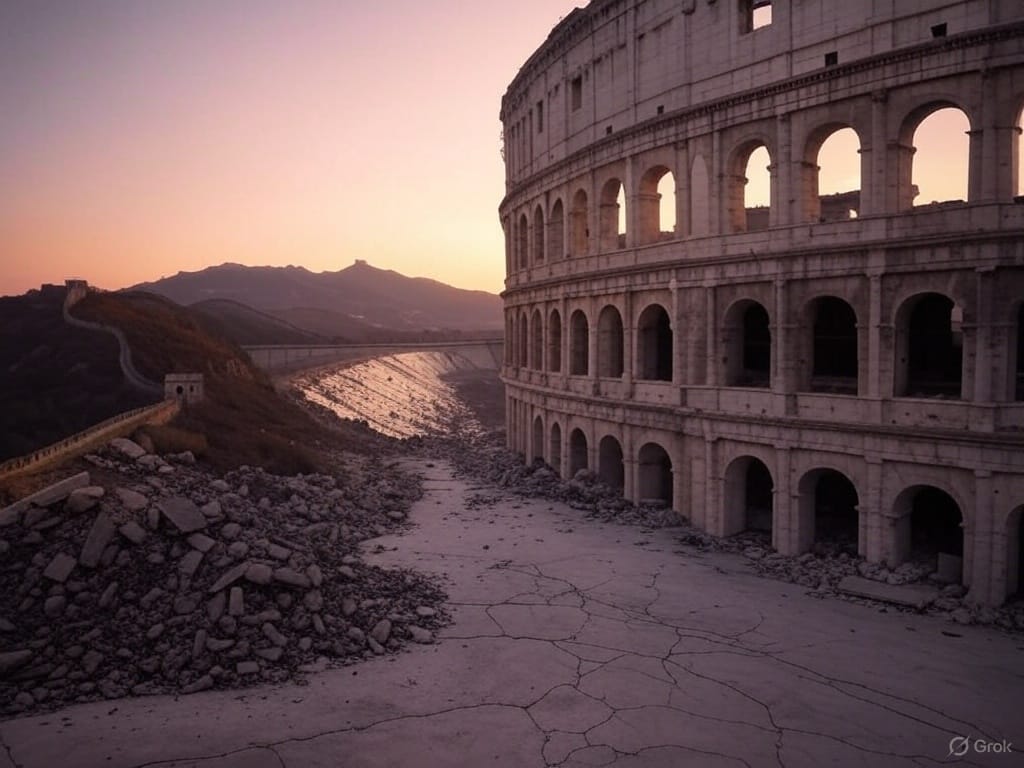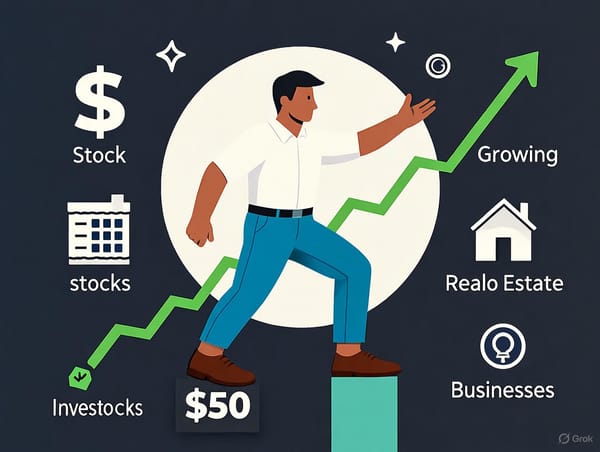Cycles of Collapse
From Rome’s crumbling aqueducts to Britain’s faded imperial banner, the cycles of collapse reveal how overexpansion and internal discord can topple even the mightiest superpowers, a warning that echoes for today’s giants like the United States and China.

History is a vast tapestry woven with the rise and fall of great powers, each thread revealing a story of ambition, triumph, and, inevitably, decline. From the marble ruins of Rome to the faded glory of imperial Britain, the cycles of collapse offer a sobering lens through which to view the modern world. These recurring patterns—overexpansion, resource depletion, internal discord, and external pressures—echo across centuries, whispering lessons to today’s dominant players. In this exploration, we’ll dissect these cycles, uncover their causes, and ponder what they might mean for the superpowers of our time.
The Anatomy of Overexpansion
At the heart of many a superpower’s collapse lies the seductive trap of overexpansion. Empires, driven by the desire for wealth, prestige, or security, stretch their borders and influence beyond what their foundations can sustain. The Roman Empire, for instance, sprawled across three continents at its peak, its legions policing a domain from the Atlantic to the Euphrates. Yet, this vastness became its undoing. The cost of maintaining far-flung garrisons, coupled with the logistical nightmare of governing diverse and restive provinces, drained Rome’s coffers and eroded its cohesion.
Similarly, the British Empire, once boasting that the sun never set on its dominion, found itself overextended by the 20th century. Colonies in Asia, Africa, and the Americas demanded resources, troops, and administration, while rivals like Germany and the United States chipped away at its economic supremacy. Overexpansion, in both cases, turned strength into vulnerability, a pattern that modern powers would do well to heed. Today, nations projecting military might or economic influence across the globe—think of the United States with its sprawling network of bases or China’s Belt and Road Initiative—face the same question: how much reach is too much?
The Weight of Resource Depletion
No empire can thrive without the fuel to sustain it, and history shows that resource depletion often accelerates collapse. Rome’s reliance on grain from North Africa and Egypt kept its cities fed, but soil exhaustion and climate shifts undermined this lifeline. The empire’s insatiable demand for timber, metals, and slaves further strained its provinces, turning abundance into scarcity. When the well runs dry, even the mightiest powers falter.
The Spanish Empire offers another stark example. Flush with silver from the New World in the 16th century, Spain seemed invincible. Yet, this wealth masked a fatal flaw: an economy overly dependent on finite resources. Inflation soared, domestic industry withered, and when the silver mines dwindled, Spain’s golden age crumbled. Fast forward to today, and we see echoes in nations tethered to oil, rare earth minerals, or aging industrial bases. The lesson is clear: a superpower that fails to adapt its resource strategy risks being buried beneath the weight of its own consumption.
The Enemy Within
While external threats often deliver the final blow, internal discord frequently sets the stage for collapse. The Roman Republic’s descent into empire was marked by civil wars, class struggles, and the erosion of civic trust. By the time barbarian tribes breached its borders, Rome was already fractured from within. The Byzantine Empire, Rome’s eastern successor, endured for centuries longer but succumbed to infighting and corruption, weakening its defenses against the Ottoman tide.
The Soviet Union, a 20th-century titan, unraveled not just under economic strain but through ideological stagnation and ethnic tensions. Its collapse in 1991 was less a triumph of Western might than a self-inflicted wound, as centralized control clashed with human nature’s demand for freedom and identity. Today’s powers are not immune. Political polarization, economic inequality, and cultural divides—visible in the United States, China, and beyond—mirror these historical fault lines. A house divided, as history teaches, cannot stand against the storms of time.
The Barbarians at the Gate
No superpower exists in a vacuum, and external forces often exploit internal weaknesses. The fall of Rome is famously tied to waves of Germanic tribes and Huns, but these invaders succeeded because Rome’s legions were overstretched and its will sapped. The British Empire, too, faced relentless challengers—rising powers like the United States and Japan, alongside colonial uprisings that bled its strength dry. External pressures don’t create collapse; they amplify it, turning cracks into chasms.
In the modern era, this dynamic persists. Geopolitical rivals, non-state actors, and even climate crises act as the “barbarians” of our time. For the United States, competition with China and Russia, coupled with asymmetric threats like cyberattacks, tests its resilience. For China, regional tensions and global pushback against its expansionism pose similar risks. The lesson? A superpower must shore up its core before facing the world—or risk being overwhelmed.
What These Cycles Mean for Today
So, what do these historical cycles tell us about the modern world’s dominant players? The United States, with its global military footprint and economic clout, mirrors Rome and Britain in its reach—but also in its challenges. Overextension in foreign conflicts, reliance on debt, and domestic polarization suggest a nation at a crossroads. China, meanwhile, rises with breathtaking speed, yet its centralized control, environmental strains, and ambitious infrastructure projects evoke Spain’s resource gamble or Rome’s logistical burdens.
These parallels don’t guarantee collapse; history isn’t a script but a guide. The difference lies in adaptability. Rome couldn’t reform its sprawling bureaucracy fast enough. Britain failed to pivot as its industrial edge dulled. Today’s powers have the advantage of hindsight—data, technology, and global connectivity offer tools to break the cycle. Yet, the patterns persist because human nature does: hubris, greed, and the allure of “more” often outweigh caution.
Breaking the Cycle—or Repeating It?
The cycles of collapse are not inevitable, but they are persistent. Overexpansion can be tempered by strategic restraint, resource depletion by innovation, internal discord by unity, and external pressures by diplomacy. History’s fallen superpowers didn’t lack warnings; they lacked the will or vision to act on them. For modern nations, the stakes are higher still, with nuclear arsenals, climate tipping points, and a hyperconnected world amplifying both risks and opportunities.
As we stand now, the question looms: will today’s giants learn from the past, or will they join the ruins of those who came before? The cycles of collapse are a mirror, reflecting not just what was, but what could be—unless we choose differently.





